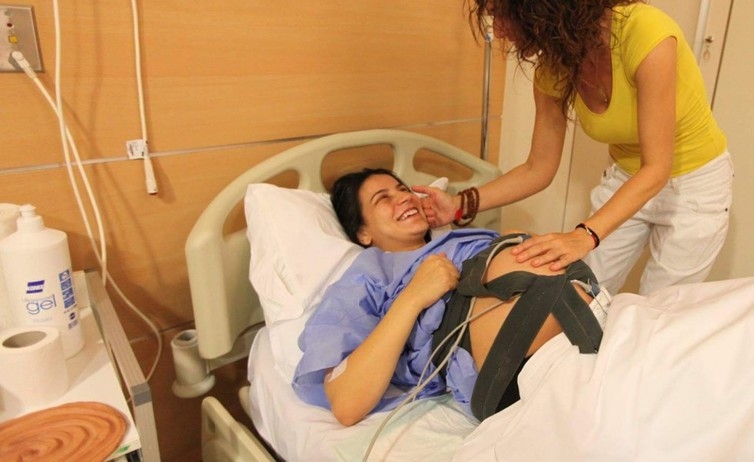Turkey has the highest caesarean section rate of any OECD country – one in every two women gives birth by caesarean. This rate has risen from 26% in 1998, far surpassing the optimal rate of 15% recommended by the World Health Organisation.
There is no doubt that the caesarean section can be a lifesaving operation for both infants and mothers. But the global increase in caesarean rates in recent decades has sparked debate about the benefits and risks, especially for surgeries performed without medical reason.
A global survey from the WHO in 2010 found that instances of maternal death, admission to intensive care units, blood transfusions and hysterectomies were three times more common for women who had on-demand caesarean sections than for those who had a vaginal delivery.
Erdoğan’s nation-building campaign
In 2012, Recep Tayyip Erdoğan, then prime minister of Turkey, put high caesarean section rates on the public agenda, condemning the procedure as a “step taken to prevent this country’s population from growing further”, adding that he also saw abortion as murder.
Following this speech, caesarean births continued to be widely criticised in the public arena, often along with abortion, as part of “a sneaky plan” to reduce Turkey’s standing on the world stage.
Thanks to resistance from women and human rights movements, a debated ban on abortion has not been enacted.
Yet, in July 2012, a “caesarean law” was adopted, making Turkey the first country to punish elective caesarean sections. This law allows doctors with high caesarean rates to be investigated or fined.
The attempt to reduce caesarean section rates is related to the pro-birth agenda of now-President Erdoğan’s Justice and Development Party, which has been in power since 2002.
The government has become obsessed with population. With a fertility rate around 2.1%, Turkey can no longer be classified as a young country. Erdoğan has called “on those sisters who are devoted to our cause. Come, please donate to this nation at least three children.”
The financial burden of caesarean surgeries on the public budget is another factor in the campaign. Due to longer hospital stays, additional medication and the need for more health-care services, caesarean births are more costly than vaginal births.
Ineffective laws
Despite the controversial law, high caesarean section rates in Turkey have not been reduced by a considerable level. Indeed, the decrease in ceasareans in public hospitals due to punitive measures have been off-set by the increase in private hospitals. The average rate in private hospitals has reached more than 65%.
These figures can only be brought down by understanding the many factors that lead to elevated caesarean rates. The issue needs to be perceived within an overall critique of medicalised childbirth and commercialised health-care systems.
Commercialisation of health systems has resulted in increased caesarean surgeries in Malaysia, India, Greece and Peru.
In 2003, reform of Turkey’s health-care system led to the commercialisation and commodification of services in line with the demands of global markets. Since then, there has been a significant increase in the number of private hospitals. It’s no coincidence that the number of caesarean sections has almost doubled in this period.
Another factor in the structural rise of caesarean rates is malpractice laws. obstetrician/gynecologists (OB/GYN) are the specialists who are sued the most in Turkey; 45% of Turkish doctors prefer caesarean sections because of malpractice lawsuits concerns, 41% because it is less risky and 27% because it is shorter, easier and safer. Easy scheduling may play a role in doctors’ potential preference for caesarean sections, as they struggle under the stress of long working hours.
Care from a midwife results in fewer caesarean births than physician care. For instance, the Netherlands, where obstetric care is provided by midwives, had one of the lowest caesarean rates: 15.6% in 2013. In Turkey, where around 19% of births were performed by midwives in 2013, the caesarean rate was 50.4%. Active involvement of midwives would also help reduce the workload of OB/GYNs.
While some women choose a caesarean section on demand due to easy planning, others may prefer it due to the fear of pain. Especially for first-time mothers, the fear about the unknown birth experience is potentially heightened by media images of childbirth and traumatic birth stories.
Putting women first
The way to overcome this fear factor is not to humiliate and disempower women as the Turkish government has done, but rather to provide better mental and physical birth preparation, which empowers women through informed consent.
Qualified midwives and doulas (professional birth companions) can help support women before, during and after birth. A WHO review of 21 trials involving 15,061 women reveals that continuous support during labour increases the likelihood of vaginal birth and lowers the incidence of caesarean sections.
The debate over high caesarean rates has been dominated by the patriarchal Turkish state in recent years. Yet, as a complex issue involving women and health professionals, it cannot be tackled by top-down restraining measures.
A genuine and more comprehensive approach needs to be developed; one that respects the rights and autonomy of women to make decisions about their own bodies. Unless necessary conditions to encourage natural vaginal birth are provided, any punitive and restrictive measures are certain to fail.
This is the first instalment of our ongoing series about birth trends worldwide.
 Selen Göbelez Dumas is a practising doula.
Selen Göbelez Dumas is a practising doula.
This article was originally published on The Conversation. Read the original article.




 What your sad desk sandwich says about your working habits
What your sad desk sandwich says about your working habits  How to look after your mental health while packing up Mum or Dad’s home
How to look after your mental health while packing up Mum or Dad’s home  Good for your health and the environment: why we should be eating oily fish
Good for your health and the environment: why we should be eating oily fish  Gut microbiome: meet Clostridium butyricum – the bacteria that helps keep us feeling our best
Gut microbiome: meet Clostridium butyricum – the bacteria that helps keep us feeling our best  Elon Musk says ketamine can get you out of a ‘negative frame of mind’. What does the research say?
Elon Musk says ketamine can get you out of a ‘negative frame of mind’. What does the research say?  Child health is in crisis in the UK – here’s what needs to change
Child health is in crisis in the UK – here’s what needs to change  Can a drug like Ozempic help treat addictions to alcohol, opioids or other substances?
Can a drug like Ozempic help treat addictions to alcohol, opioids or other substances?  Does ejaculating often reduce your risk of prostate cancer?
Does ejaculating often reduce your risk of prostate cancer?  Tapeworm larvae found in man’s brain – how did they get there?
Tapeworm larvae found in man’s brain – how did they get there?  Traditional Japanese diet associated with less brain shrinkage in women compared to western diet, says research
Traditional Japanese diet associated with less brain shrinkage in women compared to western diet, says research  Eye infections might seem like a minor complaint – but in some cases they can cause blindness and even death
Eye infections might seem like a minor complaint – but in some cases they can cause blindness and even death  UK smoking ban would have many benefits for public health – but only if it’s effectively implemented
UK smoking ban would have many benefits for public health – but only if it’s effectively implemented  Snakebites: we thought we’d created a winning new antivenom but then it flopped. Why that turned out to be a good thing
Snakebites: we thought we’d created a winning new antivenom but then it flopped. Why that turned out to be a good thing  What if flat feet were…normal? Debunking a myth about injuries
What if flat feet were…normal? Debunking a myth about injuries  Study links microplastics with human health problems – but there’s still a lot we don’t know
Study links microplastics with human health problems – but there’s still a lot we don’t know  Could ADHD drugs reduce the risk of early death? Unpacking the findings from a new Swedish study
Could ADHD drugs reduce the risk of early death? Unpacking the findings from a new Swedish study 
































